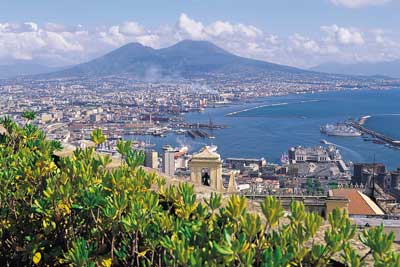Desirae Vaccaro's E-portfolio
 | Welcome to Desirae's E-portfolioHere I will talk about the eruption of Mount Vesuvius in A.D. 79 and how it affected the people of Pompeii and Herculaneum. |
Many people recognize the name Mount Vesuvius. It is largely known as a spot that tourists frequent in the Naples, Italy area. But even more so, it is known for the destruction of two cities called Pompeii and Herculaneum.
Mount Vesuvius is a volcano lying in the bay of Naples, Italy. It is what is known as a stratovolcano. A stratovolcano is a tall, conical volcano built up by many layers (strata) of hardened lava, pumice, tephra and volcanic ash. The lava that flows from stratovolcanoes typically cools and hardens before spreading far. The magma forming this lava is often felsic, or silicate minerals. Felsic tends to be lighter than most rocks and usually are not very heavy, though can be quite large. Volcanoes are complex and even scientists cannot predict when they will erupt. They can monitor the seismic activity, but as for when they will actually erupt, it may already be too late. Vesuvius had lay dormant for many years and at that time, the people of Pompeii did not know what was happening. They didn’t even know what a volcano was. The Destruction of Pompeii In A.D. 79, the inhabitants of Pompeii were long used to minor earthquakes so when the dormant volcano began to cause quakes, they thought nothing of it. When the ash started to fall, they had no idea what was happening. Twelve layers of tephra fell for 6 hours and the houses were not built as sturdy as they are today. Tephra is fragmental material produced by a volcanic eruption regardless of composition. Eventually, the weight caused houses to collapse. People were trapped inside and those who were lucky enough to be outside their homes were struck by pumice stones. What ultimately killed them was intense heat, which killed them instantly. What is interesting about Pompeii’s destruction is that for the most part, the city is pretty well preserved. Certain buildings are in outstanding condition and many of the dead bodies were well preserved also. Today, Pompeii is a popular tourist attraction. In fact, it has become the most popular tourist attraction in Italy. However, in 2010, the House of the Gladiators collapsed. It is unknown why it collapsed but there are theories.The Destruction of Herculaneum Herculaneum was a town near Mount Vesuvius that overlooked the ocean. The town was thought to have been evacuated until further excavation was done in 1981. But they later discovered some 300 skeletons, mostly along the shore. They found the city to be mostly evacuated and it had a higher population than the 20,000 Pompeiians. After the volcano had erupted, the people who were still left in the city sought refuge along the shore, which is where the bodies were found. The cause of their death was a pyroclastic surge, which is a mass of turbulent gas and rock fragments. Usually they are ejected during some volcanic eruptions. A pyroclastic surge is similar to a pyroclastic flow but its density is smaller. It contains more gas than rock. Pyroclastic surges are faster moving and can reach speeds up to 1000 mph. They can seep over ridges and hills and pyroclastic flows tend to travel downhill. While they waited to be rescued on the shore of Herculaneum, a pyroclastic surge incinerated them all. Their death was instantaneous. The heat caused their heads to explode and caused fractures in their teeth and bones. Herculaneum and Pompeii were not the only cities affected by the eruption of Mount Vesuvius. But they are the most recognized. Artifacts have been recovered and can be seen in the National Museum of Naples. We may never know the real history of what happened that fateful day, but what we can reflect on is to make sure a catastrophe like that doesn’t happen again. With our technology, we can quickly evacuate. But scientists believe Vesuvius will erupt again; it’s just a matter of when.
From left to right: A skeleton found in Herculaneum known as "the ring lady"; Pompeii as it is now; A couple found clinging to each other in the streets of Pompeii; Herculaneum as it is now; A bath house in Pompeii; Temple of Jupiter ruins today in Pompeii; A couple's mural painting found in Pompeii; Paved street of Pompeii
All images and information belong to Google and its owners.